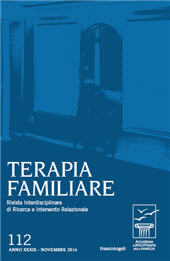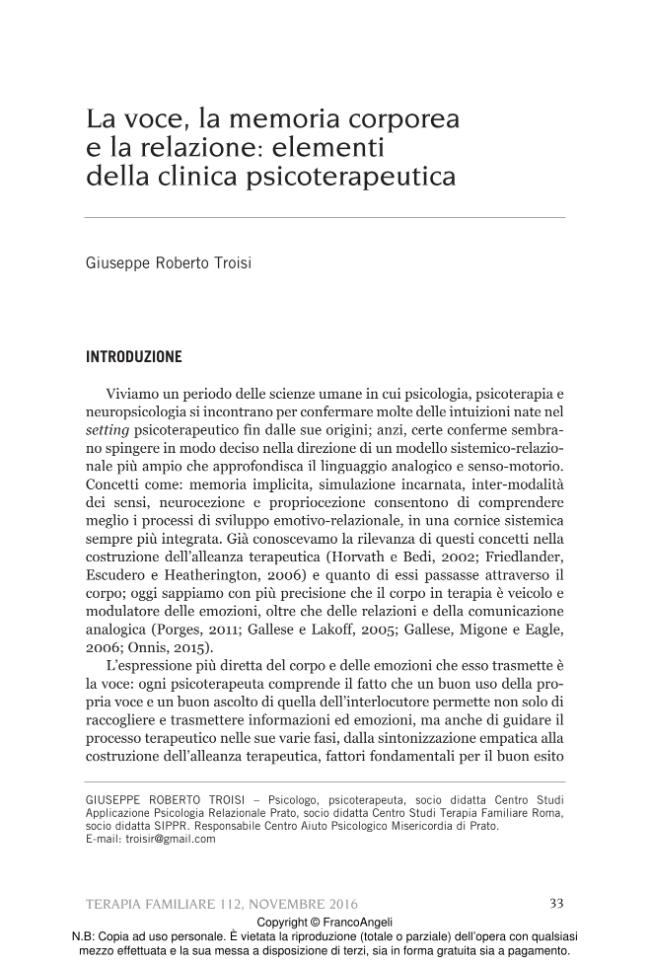La voce, la memoria corporea e la relazione : elementi della clinica psicoterapeutica
33-55 p.
In questo articolo si intende mostrare l'importanza di un buon uso della voce nello sviluppo dell'alleanza psicoterapeutica. La voce permette di gestire non solo informazioni ed emozioni, ma anche guidare il processo terapeutico nelle sue varie fasi a partire dalla sintonizzazione empatica. Nel corso dello sviluppo l'embrione viene esposto a vibrazioni, stati emotivi e suoni creando un sistema sonoro di riferimento. L'autore si chiede quanto questa trasmissione influenzi lo sviluppo neuro-sociale del bambino e il suo adattamento all'ambiente familiare e analizza in particolare le situazioni con attaccamento disorganizzato. Le recenti scoperte delle neuroscienze evidenziano la connessione tra sistema nervoso autonomo e ambiente relazionale di origine e come questa connessione passa attraverso il suono e il volto dei familiari. Dopo aver esposto la teoria polivagale di Porges e le ricerche sui neuroni specchio del gruppo di neuroscienziati di Parma, l'autore espone l'ipotesi che le voci dei conflitti familiari.
siano tra i fattori specifici nei disturbi di personalità e propone alcuni esempi di storie di persone con disturbo borderline di personalità. In tali esempi, corpo e voce permettono di comprendere i traumi sviluppati all'interno delle famiglie e delle coppie di genitori, contribuiscono a costruire un setting sicuro e guidano ipotesi d'intervento mirati. [Testo dell'editore].
In this article we intend to demonstrate the importance of a good use of the voice in the development of therapeutical alliance. The Voice allows to handle not only informations and emotions, but also to guide the therapeutical process during its various phases, starting with the empathic attunement. During its development the embryo is exposed to vibrations, emotional status and sounds. The author asks himself how much this transmission influences the neuro-social development of the baby and his adaptation to the family environment and analyses in particular those situation with a disorganised attachment. The recent discoveries in the neurosciences point out the connection between the Autonomic Nervous System and relational environment and how this connections passes through the sounds and faces of relatives. After showing Porge's Polyvagal Theory and the researches on the mirror neurones of the Parma Group, the author presents the hypothesis that the voices of familiar conflicts are among the specific facto
rs in the Personality Disorders and proposes a few example stories of people with Borderline Personality Disorder. In those examples body and voice allow us to comprehend the traumas developed within the families and the parental couples and drives aimed intervention hypothesis. [Publisher's Text].
Is part of
Terapia familiare : rivista interdisciplinare di ricerca ed intervento relazionale : 112, 3, 2016-
Articles from the same issue (available individually)
-
Information
ISSN: 1972-5442
DISCIPLINES
KEYWORDS
- Voce, corpo, alleanza terapeutica, teoria polivagale, neuroni specchio, borderline
- Voice, body, therapeutical alliance, polyvagal theory, mirror neuron, borderline



